Abstract
A new approach to assessing the cancer risk from environmental polychlorinated biphenyls (PCBs) considers both toxicity and environmental processes to make distinctions among environmental mixtures. New toxicity information from a 1996 cancer study of four commercial mixtures strengthens the case that all PCB mixtures can cause cancer, although different mixtures have different potencies. Environmental processes alter PCB mixtures through partitioning, chemical transformation, and preferential bioaccumulation; these processes can increase or decrease toxicity considerably. Bioaccumulated PCBs are of greatest concern because they appear to be more toxic than commercial PCBs and more persistent in the body. The new approach uses toxicity studies of commercial mixtures to develop a range of cancer potency estimates and then considers the effect of environmental processes to choose appropriate values for representative classes of environmental mixtures. Guidance is given for assessing risks from different exposure pathways, less-than-lifetime and early-life exposures, and mixtures containing dioxinlike compounds.
Full text
PDF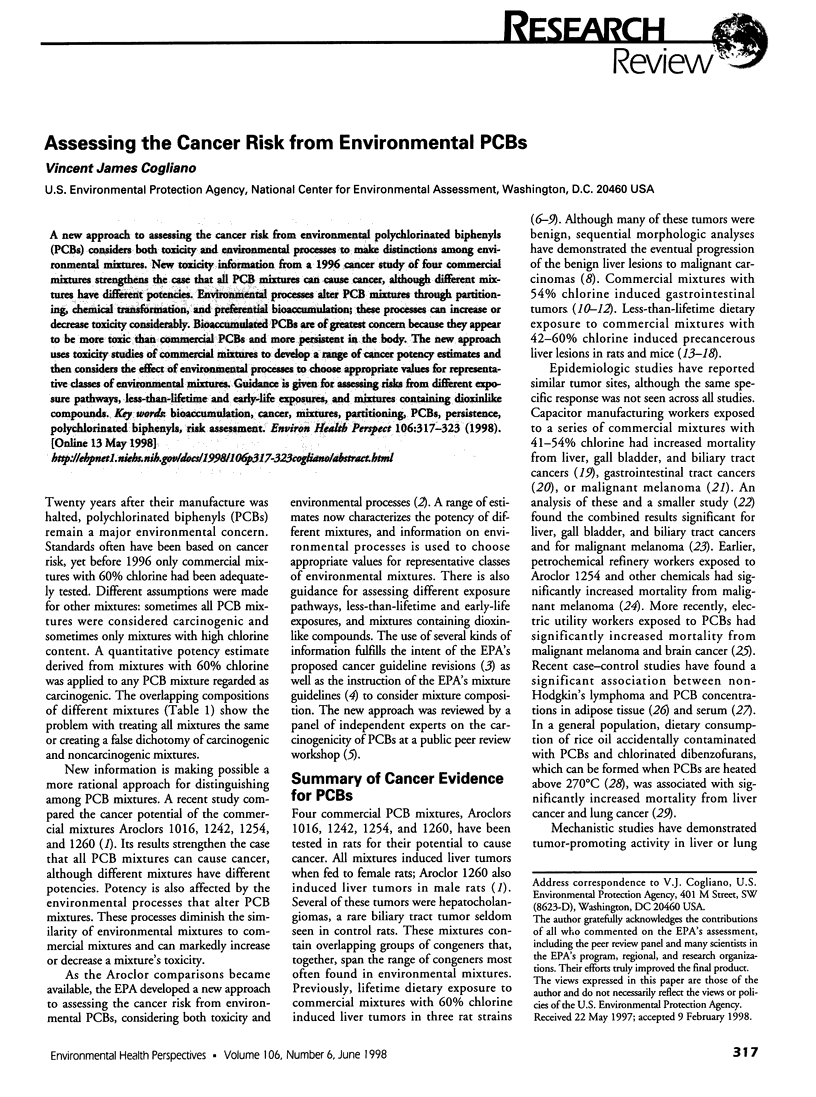
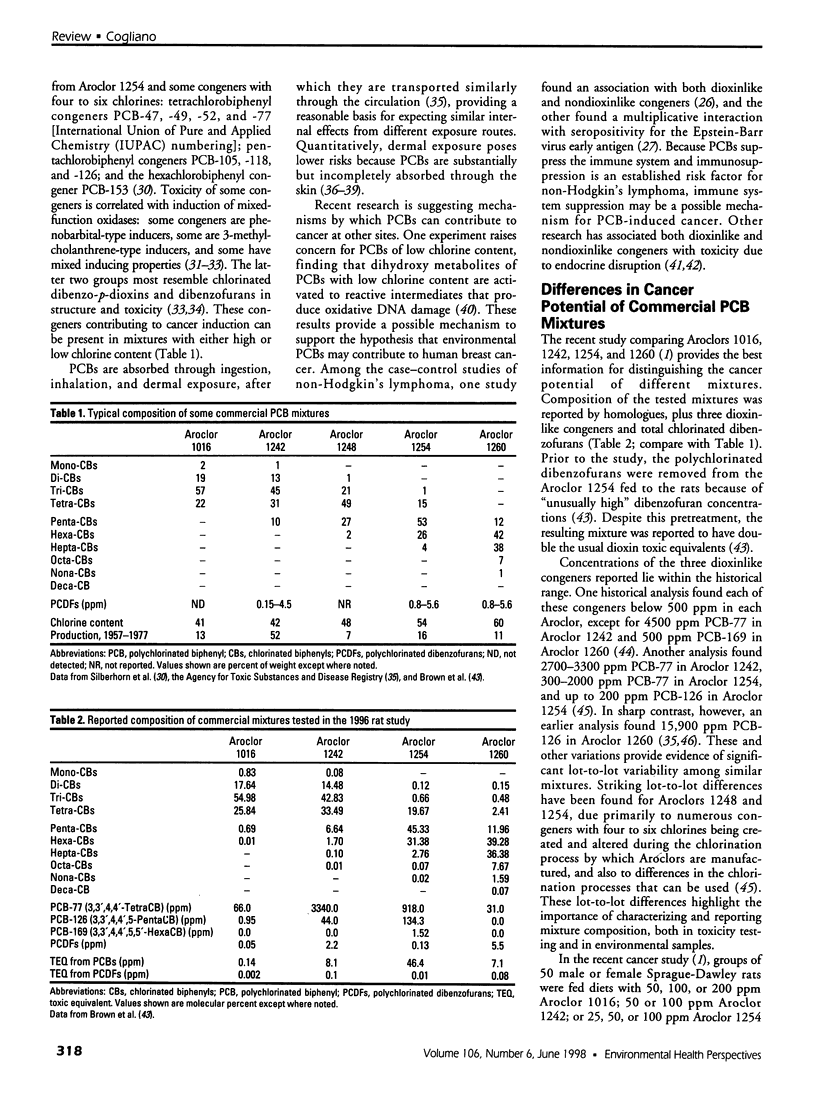
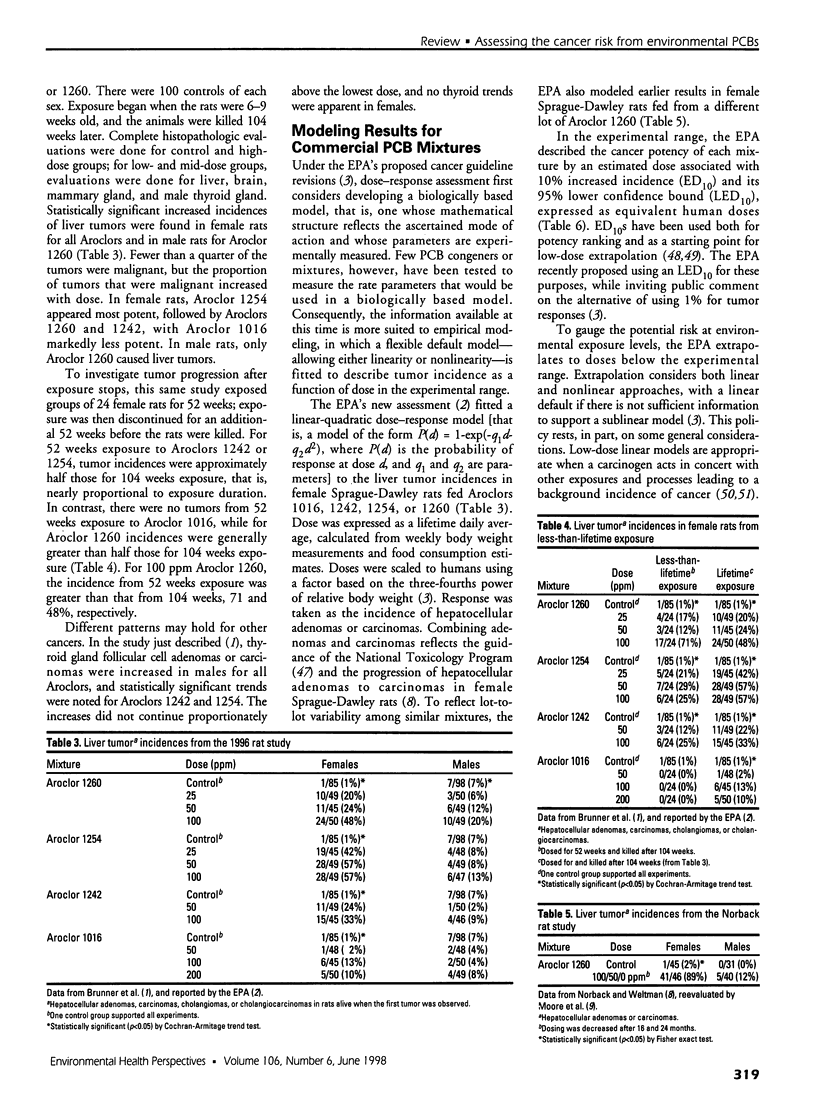
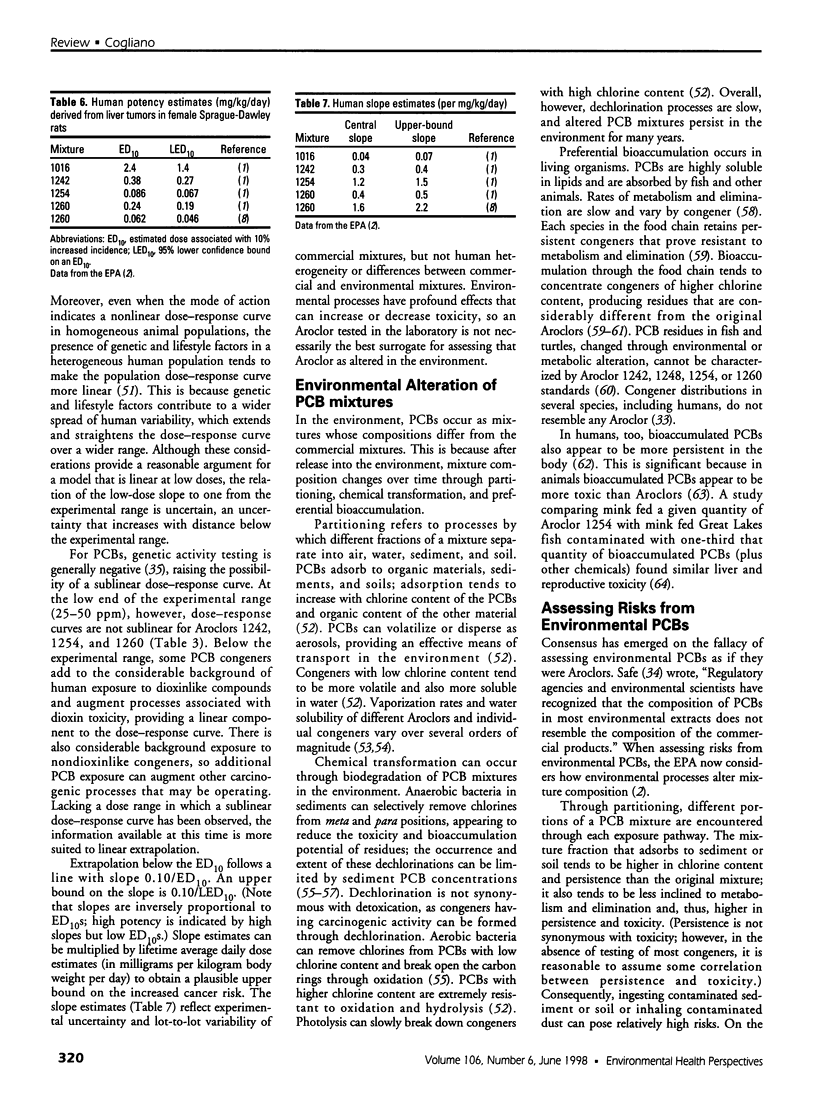
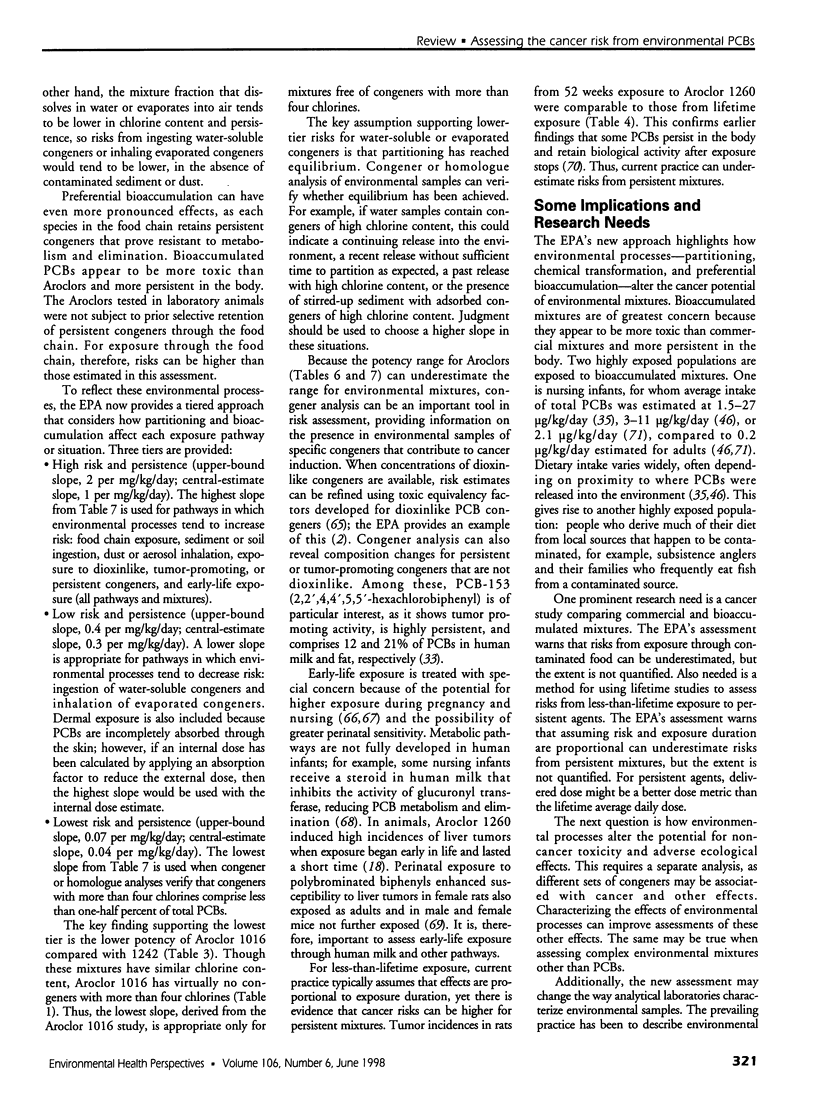
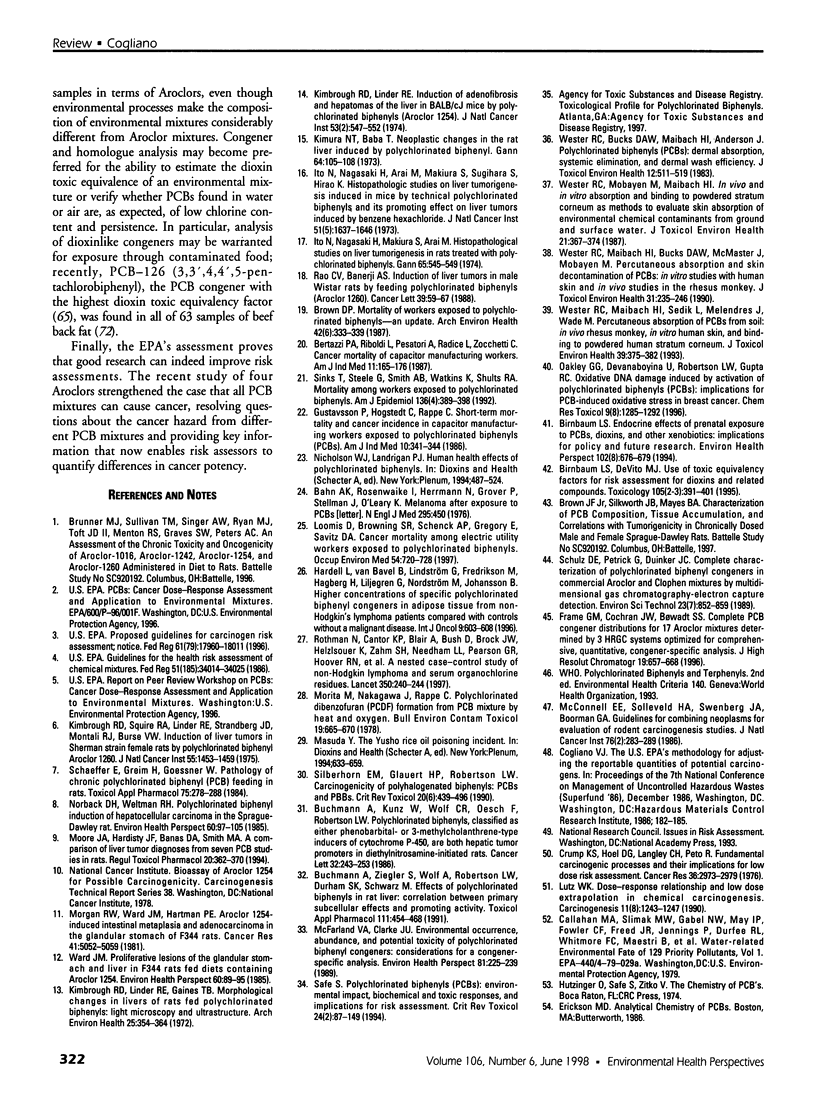
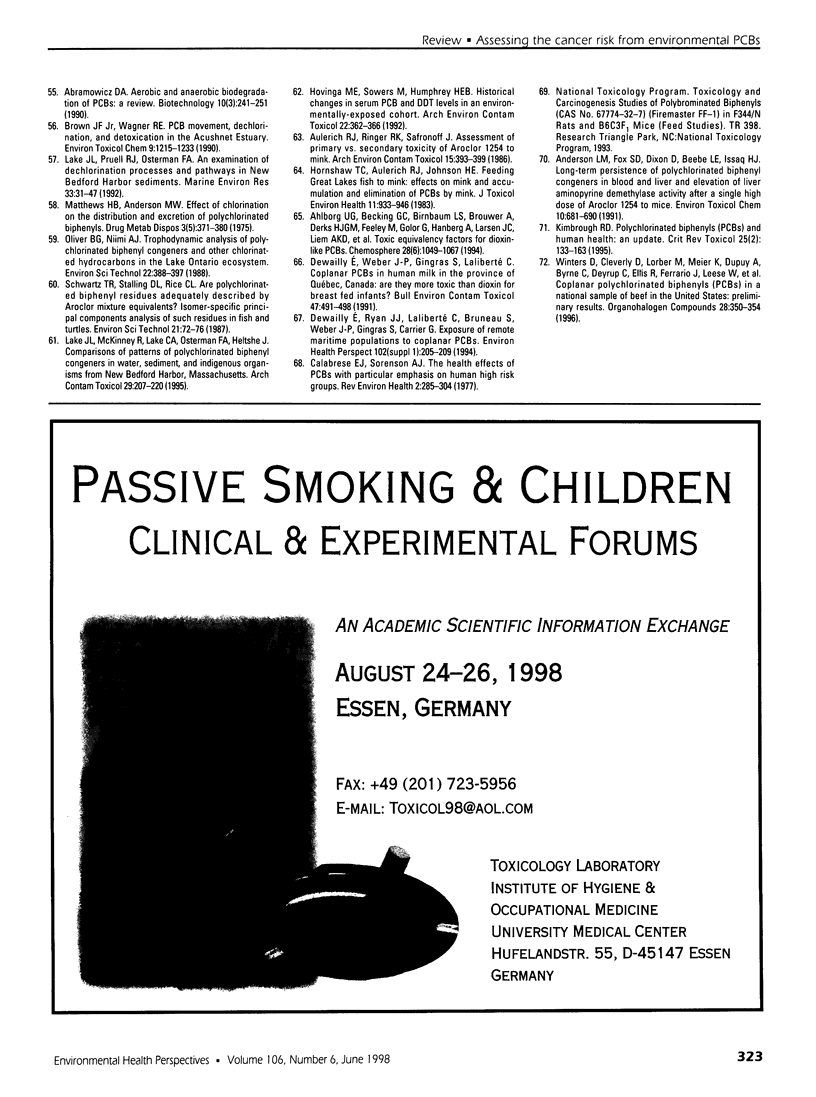
Selected References
These references are in PubMed. This may not be the complete list of references from this article.
- Aulerich R. J., Ringer R. K., Safronoff J. Assessment of primary vs. secondary toxicity of Aroclor 1254 to mink. Arch Environ Contam Toxicol. 1986 Jul;15(4):393–399. doi: 10.1007/BF01066406. [DOI] [PubMed] [Google Scholar]
- Bahn A. K., Rosenwaike I., Hermann N., Grover P., Stellman J., O'Leary K. Letter: Melanoma after exposure to PCB's. N Engl J Med. 1976 Aug 19;295(8):450–450. doi: 10.1056/NEJM197608192950820. [DOI] [PubMed] [Google Scholar]
- Bertazzi P. A., Riboldi L., Pesatori A., Radice L., Zocchetti C. Cancer mortality of capacitor manufacturing workers. Am J Ind Med. 1987;11(2):165–176. doi: 10.1002/ajim.4700110206. [DOI] [PubMed] [Google Scholar]
- Birnbaum L. S., DeVito M. J. Use of toxic equivalency factors for risk assessment for dioxins and related compounds. Toxicology. 1995 Dec 28;105(2-3):391–401. doi: 10.1016/0300-483x(95)03237-a. [DOI] [PubMed] [Google Scholar]
- Birnbaum L. S. Endocrine effects of prenatal exposure to PCBs, dioxins, and other xenobiotics: implications for policy and future research. Environ Health Perspect. 1994 Aug;102(8):676–679. doi: 10.1289/ehp.94102676. [DOI] [PMC free article] [PubMed] [Google Scholar]
- Brown D. P. Mortality of workers exposed to polychlorinated biphenyls--an update. Arch Environ Health. 1987 Nov-Dec;42(6):333–339. doi: 10.1080/00039896.1987.9934355. [DOI] [PubMed] [Google Scholar]
- Buchmann A., Ziegler S., Wolf A., Robertson L. W., Durham S. K., Schwarz M. Effects of polychlorinated biphenyls in rat liver: correlation between primary subcellular effects and promoting activity. Toxicol Appl Pharmacol. 1991 Dec;111(3):454–468. doi: 10.1016/0041-008x(91)90250-i. [DOI] [PubMed] [Google Scholar]
- Calabrese E. J., Sorenson A. J. The health effects of PCBS with particular emphasis on human high risk groups. Rev Environ Health. 1977;2(4):285–304. [PubMed] [Google Scholar]
- Crump K. S., Hoel D. G., Langley C. H., Peto R. Fundamental carcinogenic processes and their implications for low dose risk assessment. Cancer Res. 1976 Sep;36(9 PT1):2973–2979. [PubMed] [Google Scholar]
- Dewailly E., Ryan J. J., Laliberté C., Bruneau S., Weber J. P., Gingras S., Carrier G. Exposure of remote maritime populations to coplanar PCBs. Environ Health Perspect. 1994 Jan;102 (Suppl 1):205–209. doi: 10.1289/ehp.94102s1205. [DOI] [PMC free article] [PubMed] [Google Scholar]
- Dewailly E., Weber J. P., Gingras S., Laliberté C. Coplanar PCBs in human milk in the province of Québec, Canada: are they more toxic than dioxin for breast fed infants? Bull Environ Contam Toxicol. 1991 Oct;47(4):491–498. doi: 10.1007/BF01700935. [DOI] [PubMed] [Google Scholar]
- Gustavsson P., Hogstedt C., Rappe C. Short-term mortality and cancer incidence in capacitor manufacturing workers exposed to polychlorinated biphenyls (PCBs). Am J Ind Med. 1986;10(4):341–344. doi: 10.1002/ajim.4700100402. [DOI] [PubMed] [Google Scholar]
- Hornshaw T. C., Aulerich R. J., Johnson H. E. Feeding Great Lakes fish to mink: effects on mink and accumulation and elimination of PCBS by mink. J Toxicol Environ Health. 1983 Apr-Jun;11(4-6):933–946. doi: 10.1080/15287398309530396. [DOI] [PubMed] [Google Scholar]
- Hovinga M. E., Sowers M., Humphrey H. E. Historical changes in serum PCB and DDT levels in an environmentally-exposed cohort. Arch Environ Contam Toxicol. 1992 May;22(4):362–366. doi: 10.1007/BF00212554. [DOI] [PubMed] [Google Scholar]
- Ito N., Nagasaki H., Arai M., Makiura S., Sugihara S., Hirao K. Histopathologic studies on liver tumorigenesis induced in mice by technical polychlorinated biphenyls and its promoting effect on liver tumors induced by benzene hexachloride. J Natl Cancer Inst. 1973 Nov;51(5):1637–1646. doi: 10.1093/jnci/51.5.1637. [DOI] [PubMed] [Google Scholar]
- Ito N., Nagasaki H., Makiura S., Arai M. Histopathological studies on liver tumorigenesis in rats treated with polychlorinated biphenyls. Gan. 1974 Dec;65(6):545–549. [PubMed] [Google Scholar]
- Kimbrough R. D., Linder R. E., Gaines T. B. Morphological changes in livers of rats fed polychlorinated biphenyls: light microscopy and ultrastructure. Arch Environ Health. 1972 Nov;25(5):354–364. doi: 10.1080/00039896.1972.10666186. [DOI] [PubMed] [Google Scholar]
- Kimbrough R. D., Linder R. E. Induction of adenofibrosis and hepatomas of the liver in BALB-cJ mice by polychlorinated biphenyls (Aroclor 1254). J Natl Cancer Inst. 1974 Aug;53(2):547–552. doi: 10.1093/jnci/53.2.547. [DOI] [PubMed] [Google Scholar]
- Kimbrough R. D. Polychlorinated biphenyls (PCBs) and human health: an update. Crit Rev Toxicol. 1995;25(2):133–163. doi: 10.3109/10408449509021611. [DOI] [PubMed] [Google Scholar]
- Kimbrough R. D., Squire R. A., Linder R. E., Strandberg J. D., Montalli R. J., Burse V. W. Induction of liver tumor in Sherman strain female rats by polychlorinated biphenyl aroclor 1260. J Natl Cancer Inst. 1975 Dec;55(6):1453–1459. doi: 10.1093/jnci/55.6.1453. [DOI] [PubMed] [Google Scholar]
- Kimura N. T., Baba T. Neoplastic changes in the rat liver induced by polychlorinated biphenyl. Gan. 1973 Feb;64(1):105–108. [PubMed] [Google Scholar]
- Loomis D., Browning S. R., Schenck A. P., Gregory E., Savitz D. A. Cancer mortality among electric utility workers exposed to polychlorinated biphenyls. Occup Environ Med. 1997 Oct;54(10):720–728. doi: 10.1136/oem.54.10.720. [DOI] [PMC free article] [PubMed] [Google Scholar]
- Lutz W. K. Dose-response relationship and low dose extrapolation in chemical carcinogenesis. Carcinogenesis. 1990 Aug;11(8):1243–1247. doi: 10.1093/carcin/11.8.1243. [DOI] [PubMed] [Google Scholar]
- Mathews H. B., Anderson M. W. Effect of chlorination on the distribution and excretion of polychlorinated biphenyls. Drug Metab Dispos. 1975 Sep-Oct;3(5):371–380. [PubMed] [Google Scholar]
- McConnell E. E., Solleveld H. A., Swenberg J. A., Boorman G. A. Guidelines for combining neoplasms for evaluation of rodent carcinogenesis studies. J Natl Cancer Inst. 1986 Feb;76(2):283–289. [PubMed] [Google Scholar]
- McFarland V. A., Clarke J. U. Environmental occurrence, abundance, and potential toxicity of polychlorinated biphenyl congeners: considerations for a congener-specific analysis. Environ Health Perspect. 1989 May;81:225–239. doi: 10.1289/ehp.8981225. [DOI] [PMC free article] [PubMed] [Google Scholar]
- Moore J. A., Hardisty J. F., Banas D. A., Smith M. A. A comparison of liver tumor diagnoses from seven PCB studies in rats. Regul Toxicol Pharmacol. 1994 Dec;20(3 Pt 1):362–370. doi: 10.1006/rtph.1994.1081. [DOI] [PubMed] [Google Scholar]
- Morgan R. W., Ward J. M., Hartman P. E. Aroclor 1254-induced intestinal metaplasia and adenocarcinoma in the glandular stomach of F344 rats. Cancer Res. 1981 Dec;41(12 Pt 1):5052–5059. [PubMed] [Google Scholar]
- Morita M., Nakagawa J., Rappe C. Polychlorinated dibenzofuran (PCDF) formation from PCB mixture by heat and oxygen. Bull Environ Contam Toxicol. 1978 Jun;19(6):665–670. doi: 10.1007/BF01685855. [DOI] [PubMed] [Google Scholar]
- Norback D. H., Weltman R. H. Polychlorinated biphenyl induction of hepatocellular carcinoma in the Sprague-Dawley rat. Environ Health Perspect. 1985 May;60:97–105. doi: 10.1289/ehp.856097. [DOI] [PMC free article] [PubMed] [Google Scholar]
- Oakley G. G., Devanaboyina U., Robertson L. W., Gupta R. C. Oxidative DNA damage induced by activation of polychlorinated biphenyls (PCBs): implications for PCB-induced oxidative stress in breast cancer. Chem Res Toxicol. 1996 Dec;9(8):1285–1292. doi: 10.1021/tx960103o. [DOI] [PubMed] [Google Scholar]
- Rothman N., Cantor K. P., Blair A., Bush D., Brock J. W., Helzlsouer K., Zahm S. H., Needham L. L., Pearson G. R., Hoover R. N. A nested case-control study of non-Hodgkin lymphoma and serum organochlorine residues. Lancet. 1997 Jul 26;350(9073):240–244. doi: 10.1016/S0140-6736(97)02088-6. [DOI] [PubMed] [Google Scholar]
- Safe S. H. Polychlorinated biphenyls (PCBs): environmental impact, biochemical and toxic responses, and implications for risk assessment. Crit Rev Toxicol. 1994;24(2):87–149. doi: 10.3109/10408449409049308. [DOI] [PubMed] [Google Scholar]
- Schaeffer E., Greim H., Goessner W. Pathology of chronic polychlorinated biphenyl (PCB) feeding in rats. Toxicol Appl Pharmacol. 1984 Sep 15;75(2):278–288. doi: 10.1016/0041-008x(84)90210-2. [DOI] [PubMed] [Google Scholar]
- Silberhorn E. M., Glauert H. P., Robertson L. W. Carcinogenicity of polyhalogenated biphenyls: PCBs and PBBs. Crit Rev Toxicol. 1990;20(6):440–496. doi: 10.3109/10408449009029331. [DOI] [PubMed] [Google Scholar]
- Sinks T., Steele G., Smith A. B., Watkins K., Shults R. A. Mortality among workers exposed to polychlorinated biphenyls. Am J Epidemiol. 1992 Aug 15;136(4):389–398. doi: 10.1093/oxfordjournals.aje.a116511. [DOI] [PubMed] [Google Scholar]
- Ward J. M. Proliferative lesions of the glandular stomach and liver in F344 rats fed diets containing Aroclor 1254. Environ Health Perspect. 1985 May;60:89–95. doi: 10.1289/ehp.856089. [DOI] [PMC free article] [PubMed] [Google Scholar]
- Wester R. C., Bucks D. A., Maibach H. I., Anderson J. Polychlorinated biphenyls (PCBs): dermal absorption, systemic elimination, and dermal wash efficiency. J Toxicol Environ Health. 1983 Oct-Dec;12(4-6):511–519. doi: 10.1080/15287398309530445. [DOI] [PubMed] [Google Scholar]
- Wester R. C., Maibach H. I., Bucks D. A., McMaster J., Mobayen M., Sarason R., Moore A. Percutaneous absorption and skin decontamination of PCBs: in vitro studies with human skin and in vivo studies in the rhesus monkey. J Toxicol Environ Health. 1990 Dec;31(4):235–246. doi: 10.1080/15287399009531453. [DOI] [PubMed] [Google Scholar]
- Wester R. C., Maibach H. I., Sedik L., Melendres J., Wade M. Percutaneous absorption of PCBs from soil: in vivo rhesus monkey, in vitro human skin, and binding to powdered human stratum corneum. J Toxicol Environ Health. 1993 Jul;39(3):375–382. doi: 10.1080/15287399309531758. [DOI] [PubMed] [Google Scholar]
- Wester R. C., Mobayen M., Maibach H. I. In vivo and in vitro absorption and binding to powered stratum corneum as methods to evaluate skin absorption of environmental chemical contaminants from ground and surface water. J Toxicol Environ Health. 1987;21(3):367–374. doi: 10.1080/15287398709531025. [DOI] [PubMed] [Google Scholar]


